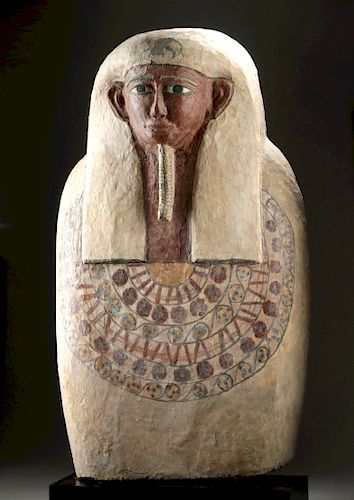Egyptian Painted Wood / Gesso Sarcophagus Panel
Lot 9
About Seller
Artemis Fine Arts
686 S Taylor Ave, Ste 106
Louisville, CO 80027
United States
Selling antiquities, ancient and ethnographic art online since 1993, Artemis Gallery specializes in Classical Antiquities (Egyptian, Greek, Roman, Near Eastern), Asian, Pre-Columbian, African / Tribal / Oceanographic art. Our extensive inventory includes pottery, stone, metal, wood, glass and textil...Read more
Categories
Estimate:
$35,000 - $50,000
Absentee vs Live bid
Two ways to bid:
- Leave a max absentee bid and the platform will bid on your behalf up to your maximum bid during the live auction.
- Bid live during the auction and your bids will be submitted real-time to the auctioneer.
Bid Increments
| Price | Bid Increment |
|---|---|
| $0 | $25 |
| $300 | $50 |
| $1,000 | $100 |
| $2,000 | $250 |
| $5,000 | $500 |
| $10,000 | $1,000 |
| $20,000 | $2,500 |
| $50,000 | $5,000 |
| $100,000 | $10,000 |
| $200,000 | $20,000 |
About Auction
By Artemis Fine Arts
Sep 26, 2019
Set Reminder
2019-09-26 10:00:00
2019-09-26 10:00:00
America/New_York
Bidsquare
Bidsquare : Exceptional Day 1: Antiquities & Asian Art
https://www.bidsquare.com/auctions/artemis-gallery/exceptional-day-1-antiquities-asian-art-4437
Day 1 of an important 2-day auction featuring exceptional, museum-worthy examples of Egyptian, Greek, Etruscan, Roman, Viking, Russian, Near Eastern, as well as Asian Art from China, Japan, Thailand, Vietnam, Burma and India. Artemis Fine Arts info@artemisgallery.com
Day 1 of an important 2-day auction featuring exceptional, museum-worthy examples of Egyptian, Greek, Etruscan, Roman, Viking, Russian, Near Eastern, as well as Asian Art from China, Japan, Thailand, Vietnam, Burma and India. Artemis Fine Arts info@artemisgallery.com
- Lot Description
Egypt, Late Dynastic Period, 25th Dynasty, ca. 664 to 525 BCE. A stunning Egyptian sarcophagus panel, hand-carved from cedar and covered in layers of painted gesso. The top of the cover presents a mesmerizing guise that is theatrical yet semi-veristic, with ovoid copper eyes with elongated canthi surrounding white-painted sclera and black irises, a slender nose, cupped ears, and full lips above a rounded chin. Beneath the chin is an elaborate false beard with stripes of black and green atop a yellow ground, and above the forehead is a highly stylized scarab beetle representative of immortality and resurrection. A gorgeous broad collar hangs atop the chest and displays two rings each of red linear bands, red poppy flowers, and yellow circles filled with blue-and-red spots. The verso is hollow to fit around the form of the deceased, and mortises along the verso illustrate how it would have attached to the lower sarcophagus body. Size: 26" W x 45" H (66 cm x 114.3 cm); 49" H (124.5 cm) on included custom stand.
Ancient Egyptians believed it was of the utmost importance to preserve a body of the deceased, because the soul needed a place to reside after the death. Preservation of the body was done via mummification - a process involving the removal of internal organs that were placed in canopic jars, wrapping body in linen, and then embalming. Death masks and sarcophagus panels like this example were created so that the "ba" - the part of the soul that left the body each day - could recognize their old form body and become rejoined each evening with the "ka" - the part of the soul that permanently stayed with the body.
Interestingly, cedar wood was not native to Egypt. Egypt did not have verdant forests filled with tall trees, and unfortunately most of its native lumber was of relatively poor quality. Thus, they relief on importing to acquire hardwoods - ebony imported from Africa, cedar and pine from Lebanon. One fabulous obelisk inscription by Thutmose III attests to the luxury of hardwoods. It reads as follows, "They brought to me the choicest products...consisting of cedar, juniper and of meru wood...all the good sweet woods of God's Land." The rarity of cedar meant that masks like this example were reserved for those who could afford them.
A stylistically-similar example, of roughly half the size and from a later dynasty, hammered for $68,750 at Christie's, New York Antiquities auction (sale 3748, June 4, 2015, lot 168): https://www.christies.com/lotfinder/ancient-art-antiquities/an-egyptian-wood-coffin-lid-30th-dynasty-5903892-details.aspx?from=searchresults&intObjectID=5903892&sid=54df11d9-d913-48cb-b4ed-86e693bda9c6
Provenance: ex-private Austin, Texas, USA collection, acquired in 2018; ex-Aphrodite Ancient Art Gallery, New York, New York, USA; ex-private Florida, USA collection, acquired in 2008; ex-private German collection, acquired in 1979; accompanied by Art Loss Register certificate, reference #S00109057
All items legal to buy/sell under U.S. Statute covering cultural patrimony Code 2600, CHAPTER 14, and are guaranteed to be as described or your money back.
A Certificate of Authenticity will accompany all winning bids.
We ship worldwide and handle all shipping in-house for your convenience.
#147169Restoration to several areas of head, lower corners, and periphery, with stabilization material visible in some areas, and some fill and overpainting, especially around the lower third of the body. Ancient loss and stabilization to verso. Small chips and abrasions across body, head, peripheries, and verso, with light fading to original pigmentation, and stable insect damage on verso. Great traces of original pigmentation throughout. Comes with Art Loss Register Certificate.Condition
- Shipping Info
-
All shipping is handled in-house for your convenience. Your invoice from Artemis Gallery will include shipping calculation instructions. If in doubt, please inquire BEFORE bidding for estimated shipping costs for individual items.
-
- Buyer's Premium



 EUR
EUR CAD
CAD AUD
AUD GBP
GBP MXN
MXN HKD
HKD CNY
CNY MYR
MYR SEK
SEK SGD
SGD CHF
CHF THB
THB



















